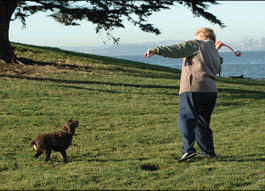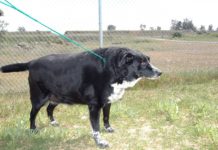The 3 Most Common and Preventable Canine Maladies
What is the worst part about these strikingly common conditions dogs get? They are all entirely preventable. Obesity, periodontitis, and overgrown nails affect more dogs in the United States than any other diseases, and can be just as harmful.
Canine Pancreatitis
Pancreatitis literally means inflammation of the pancreas, the glandular organ that secretes enzymes needed to digest food. When something causes these enzymes to be activated prematurely, they can actually begin to digest the pancreas itself, resulting in pain and inflammation. Pancreatitis occurs in two different forms, acute and chronic, and both may be either mild or severe. Acute pancreatitis occurs suddenly and is more often severe, while chronic pancreatitis refers to an ongoing inflammation that is usually less severe and may even be subclinical (no recognizable symptoms). Acute pancreatitis can be extremely painful, and can become life-threatening if the inflammation spreads, affecting multiple organs and systems. Symptoms commonly include anorexia (loss of appetite), vomiting, weakness, depression, and abdominal pain. Abdominal pain in a dog may be exhibited as restlessness or not wanting to move; a hunched appearance or a praying position, with the chest down and the rear raised; or vocalization (crying or whimpering). Additional symptoms may include diarrhea, drooling, fever, and collapse.
29 Dog Breeds Predisposed to Hypothyroidism
These 29 dog breeds are the top most inclined to develop hypothyroidism as they age.
A Healthy Pancreas for Canine Diabetes Prevention
The pancreas is an elongated gland, light tan or pinkish in color, nestled alongside the small intestine and adjacent to the stomach. The organ is composed of two functionally separate types of glandular tissue, each which performs a vital and disparate role in the dog's body.
Keeping Your Dog Fit and Healthy
Compare the actions and functions of the musculoskeletal system to a finely tuned symphonic orchestra. Each and every instrument (each of the dozens of independent muscles in the dog) contributes to the whole. For one instrument to be heard above the rest, the sounds from other instruments must be softened – and for one set of muscles to flex or contract a joint, that joint’s muscles of extension must relax, and vice versa. The music of the muscles is this month’s stop on the Tour of the Dog.
Is Your Dog Overweight?
This has become a nation of fat people – and fat dogs. Once again our dogs are mirroring us, no matter how bad that picture looks. It has been estimated that (depending on the survey and the way “obese” and “overweight” are defined) from about 25 percent to more than half of dogs seen by veterinarians are overweight or obese, and many practitioners feel that even these numbers grossly underestimate the true extent of the problem.
Safe Canine Weight Loss Tips
Recent studies indicate that up to 40 percent of dogs in the United States may be obese. The risks associated with canine obesity include musculoskeletal disorders such as osteoarthritis, compromised immune function, problems during surgical procedures, delayed wound healing, skin infections, and diabetes.
Battling Dog Obesity – Focus on Exercise and Diet
Obesity has been defined as a body weight 10 to 20 percent above the ideal weight for that individual dog. The rule of thumb offered by most sources is that if you sweep your fingers lightly over your dog’s ribs and shoulders you should be able to feel the outline of the bones. If you must use pressure to find the ribs, your dog is overweight. Viewed from above, your dog should have a noticeable waist. If Bowser fails either of these two tests, it’s time for doggy dieting. Veterinarians today consider obesity to be the leading health problem among our dogs and cats. According to the U.C. Davis School of Veterinary Medicine’s Book of Dogs, this manifestation of malnutrition affects an estimated 25-44 percent of our canine companions.
Canine Diabetes, A Common Yet Serious Problem
Diabetes is a common and serious problem in pets. Formally known as diabetes mellitus (the sweet sickness), it’s a disorder of the pancreas gland. The pancreas produces a hormone called insulin, whose purpose is to drive nutrients, specifically glucose, or blood sugar, into the cells. It’s the body’s most important fuel molecule. Good management is the key to longevity for diabetic dogs.
Treating Your Dog’s Hypothyroidism
Hypothyroidism (underactive or low thyroid) is a common disorder in dogs. A variety of breeds are known to be genetically predisposed, including the Labrador Retriever, Golden Retriever, Dachshund, Boxer, Doberman, and Cocker Spaniel. (It's normal for sighthounds such as the Greyhound to have relatively low thyroid levels as a result of their unique physiology; these levels are not a sign of pathology in these breeds.)
Canine Swimming Lessons: The Perfect Exercise For Your Dog
For those of us who regularly swim for fitness, we know why swimming is often referred to as “the perfect exercise.” In addition to the physical benefits shared with other forms of aerobic exercise, swimming offers some unique benefits. It eliminates the effects of weight-bearing on the joints, exercises the entire body – upper and lower – at the same time, and, in most cases, is something we can do for our entire lives, even if age precludes us from taking part in other forms of exercise. The physical benefits of swimming are the same for your canine companion as they are for you – that is, if you have a dog who will swim. Even though they actually have a stroke named after them, the notion that all dogs are “natural swimmers” is an erroneous one. Some breeds were developed to work in water and are more physically adapted for swimming than others. The problem here is not getting these dogs into the water, but keeping them on terra firma when we want them to stay clean and dry. However, occasionally, even a water breed shows disdain for water – yes, there are some Labrador Retrievers who hate swimming. Conversely, there are dogs you’d never imagine taking kindly to the water who become devoted and skilled swimmers. Although not blessed with the physical advantages of a water breed, and despite sinking rear ends or heavy, wet coats, these Boston Terriers, Rhodesian Ridgebacks, and Siberian Huskies have learned to enjoy swimming. They don’t know or care that they have to work a little harder than a Poodle, Cocker Spaniel, or a Newfoundland – they just want to have fun!
Keeping Your Dog Thin is a Lifesaver
but he looks and acts much older. He's at high risk of a short

















